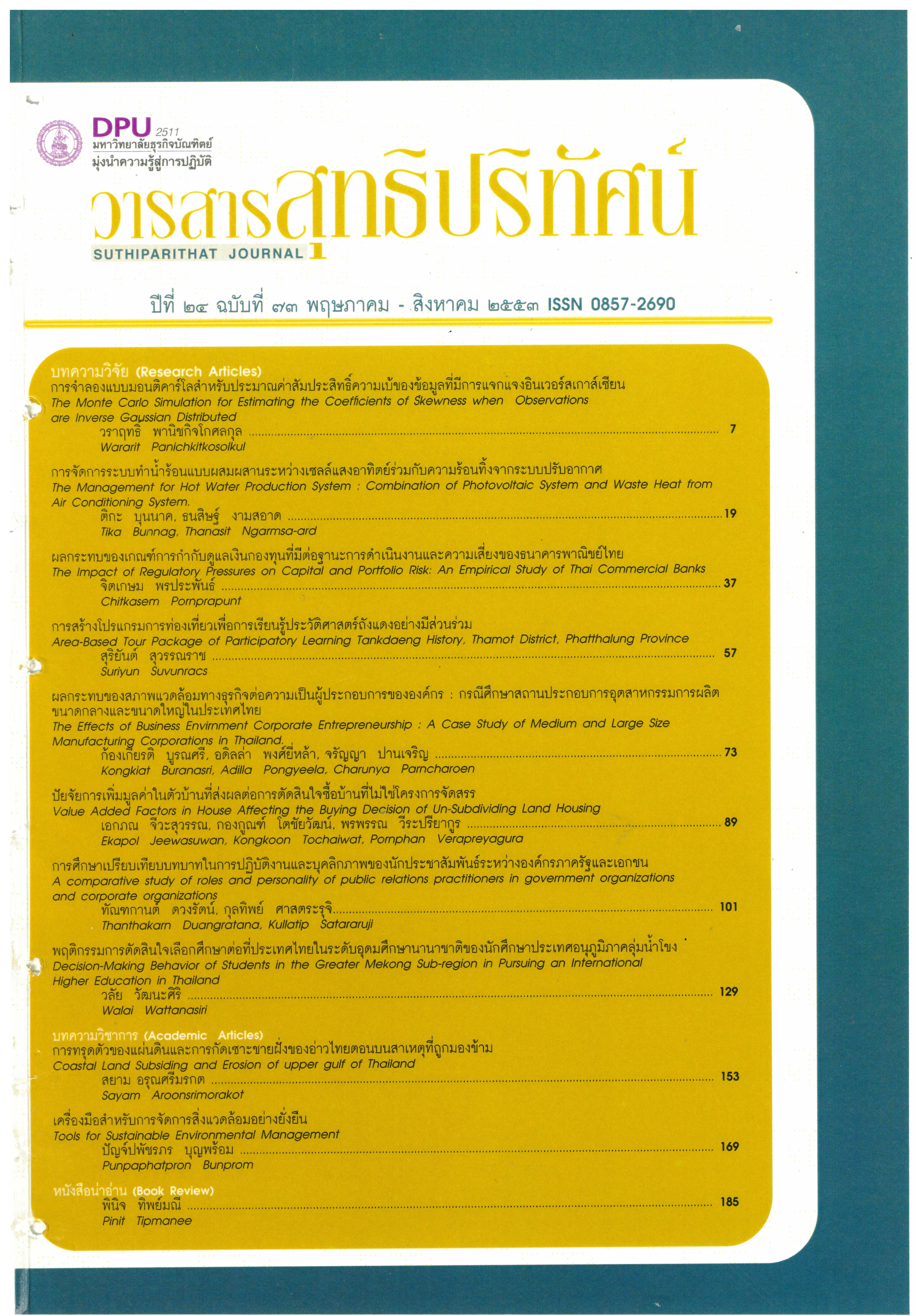ผลกระทบของสภาพแวดล้อมทางธุรกิจต่อความเป็นผู้ประกอบการขององค์การ : กรณีศึกษา สถานประกอบการอุตสาหกรรมการผลิตขนาดกลางและขนาดใหญ่ในประเทศไทย
คำสำคัญ:
ความเป็นผู้ประกอบการขององค์การ, สภาพแวดล้อมทางธุรกิจ, การวิเคราะห์สมการเชิงโครงสร้างบทคัดย่อ
การวิจัยครั้งนี้มีจุดมุ่งหมายเพื่อพัฒนาและตรวจสอบความเที่ยงตรงของโมเดลความเป็นผู้ประกอบการขององค์การ ประชากรกลุ่มเป้าหมาย (Target Population) คือ สถานประกอบการอุตสาหกรรมการผลิตขนาดกลางและขนาดใหญ่ในพื้นที่การนิคมอุตสาหกรรมแห่งประเทศไทย ผู้วิจัยใช้แบบสอบถามเป็นเครื่องมือที่ใช้ในการวิจัย และเก็บตัวอย่างได้จำนวน 611 แห่ง อัตราการตอบกลับ (Response Rate) คิดเป็นร้อยละ 52 การวิเคราะห์สมการเชิงโครงสร้างด้วยโปรแกรม LISREL 8.50 ผลการวิเคราะห์ข้อมูลพบว่า โมเดลการวิเคราะห์มีความสอดคล้องกับข้อมูลเชิงประจักษ์ ซึ่งแสดงให้เห็นว่าปัจจัยสภาพแวดล้อมภายนอกองค์การ และปัจจัยสภาพแวดล้อมภายในองค์การส่งอิทธิพลในทางบวกต่อความเป็นผู้ประกอบการขององค์การโดยปัจจัย สภาพแวดล้อมภายในองค์การมีอิทธิพลต่อความเป็นผู้ประกอบการขององค์การมากกว่าปัจจัยสภาพแวดล้อมภายนอกองค์การ
เอกสารอ้างอิง
นงลักษณ์ วิรัชชัย. (2542). โมเดลลิสเรล สถิติวิเคราะห์สำหรับการวิจัย. กรุงเทพฯ : จุฬาลงกรณ์มหาวิทยาลัย.
สุภมาส อังศุโชติ, สมถวิล วิจิตรวรรณา และรัชชนีกูล ภิญโญภานุวัฒน์. (2551). สถิติวิเคราะห์สำหรับการวิจัยทางสังคมศาสตร์และพฤติกรรมศาสตร์ : เทคนิคการใช้โปรแกรม LISREL. กรุงเทพฯ : มิสชั่น มีเดีย.
ศุภวรรณ ทรงอำนวยคุณ.(2548). อิทธิพลของความเป็นผู้ประกอบการที่มีต่อการสร้างสรรค์ทางปัญญาและการบริการของภาควิชาในมหาวิทยาลัย : การประยุกต์โมเดลสมการโครงสร้างพหุระดับแบบอิทธิพลย้อนกลับ. วิทยานิพนธ์ (ค.ด.)., จุฬาลงกรณ์มหาวิทยาลัย.
Antoncic, B., & Hisrich, R. D. (2000). Intrapreneurship modelling in transition economies: A comparison of Slovenia and the United States. Journal of Developmental Entrepreneurship. 5(1). 21-40.
Antoncic, B., & Hisrich, R. D. (2001). Intrapreneurship: construct refinement and cross cultural validation. Journal of Business Venturing. 16. 495-527.
Bhardwaj, B. R., Sushill., & Momaya, K. (2007). Corporate Entrepreneurship : Application of Moderator Method. Singapore Management Review. 29(1). 47-58.
Burgelman, R. A. (1984). Design for corporate entrepreneurship in established firms. California Management Review. 16(3). 154-166.
Carrier, C. (1996). Intrapreneurship in small businesses : an exploratory study. Entrepreneurship Theory and Practice. 21(1). 5-20.
Covin, J. G., & Miles, M. P. (1999). Corporate entrepreneurship and the pursuit of compettitive advantage. Entrepreneurship Theory and Practice. 23(4). 47-63.
Covin, J. G., & Slevin, D. P. (1991). A conceptual model of entrepreneurship as firm behavior. Entrepreneurship Theory and Practice. 16(1). 7-25.
Covin, J. G., Green, K. M., & Slevin, D. P. (2006). Strategic Process Effects on the Entrepreneurial Orientation-Sales Growth Rate Relationship. Entrepreneurship Theory and Practice. 30(1). 57.
Dess, G. D., Lumpkin, G. T., & McGee, J. E. (1999). Linking corporate entrepreneurship to strategy, structure and process: suggested research directions. Entrepreneurship Theory and Practice. 23(3). 85-102.
Ellis, R. J., & Taylor, N. T. (1987). Specifying Entrepreneurship. In N. C. Churchill, J. A.
Guth, W., & Ginsberg, A. (1990). Guest editor’s introduction: Corporate entrepreneurship. Strategies Management Journal. 11. 5-16.
Hornsby, J. S., Kuratko, D. F., & Zahra, S. A. (2002). Middle managers’ perception of the internal environment for corporate entrepreneurship:assessing a measurement scale. Journal of Business Venturing. 17(3). 253-273.
Kim, O. T. E., & McIntoch, J. C. (1997). The relevance of American motivation theories to managing in an Asian context : An examination of the cross-cultural transferability of American management to Korea. Journal of International Business & Entrepreneurship. 5(1). 43-60.
Margarietha, J. S. (2007). Entrepreneurial intensity : The influence of antecedents to corporate entrepreneurship in firms operating in South Africa. Philosophiae Doctor of Business management. University of Stellenbosch.
Morris, M. H., Kuratko, D. F., & Covin, J. G. (2008). Corporate entrepreneurship & Innovation. Mason, Ohio: Thomson South-Western.
Pinchot III, G. (1985). Intrapreneuring: You don’t have to leave the corporation to be come an entrepreneur. New York: Harper & Row.
Robert, E. E. (1980). New Ventures for corporate growth. Harvard Business Review, 130.
Robert, C. H., & Don, H. (1994). Critical Contingencies in Joint Venture Management : Some Lessons From Managers. Organization Science. 5(4). 594-607.
Schollhammer, H. (1982). Internal corporate entrepreneurship. In D. L. Sexton & K. M. Vesper. (Eds.), Encyclopedia of Entrepreneurship. Englewood Cliffs, NJ: Prentice-Hall, Inc.
Ucbasaran, D., Westhead, P., & Wright, M. (2001). The focus of entrepreneurial research : contextual and process issues. Entrepreneurship Theory and Practice. 25(4). 57-80.
Zahra, S. A. (1991). Predictors and financial outcomes of corporate entrepreneurship: an exploratory study. Journal of Business Venturing. 6(4). 259-285.
Zahra, S. A. (1993a). Environment, Corporate Entrepreneurship, and Financial Performance : A Taxonomic Approach. Journal of Business Venturing. 8. 319-340.
Zahra, S. A., & Garvis, D. M. (2000). International corporate entrepreneurship and firm performance: The moderating effect of international environmental hostility. Journal of Business Venturing. 15(5,6). 469.
Zhan, J. (2006). Development of Theory on Entrepreneurial Orientation: Empirical Evidences from Hebei, China and Flanders, Belgium. Doctor in Applied Economic Sciences. Belgium: Ghent University.
ดาวน์โหลด
เผยแพร่แล้ว
รูปแบบการอ้างอิง
ฉบับ
ประเภทบทความ
สัญญาอนุญาต
เนื้อหาและข้อมูลในบทความที่ลงตีพิมพ์ในวารสารสุทธิปริทัศน์ ถือเป็นข้อคิดเห็นและความรับผิดชอบของผู้เขียนบทความโดยตรงซึ่งกองบรรณาธิการวารสาร ไม่จำเป็นต้องเห็นด้วย หรือร่วมรับผิดชอบใด ๆ
บทความ ข้อมูล เนื้อหา รูปภาพ ฯลฯ ที่ได้รับการตีพิมพ์ในวารสารสุทธิปริทัศน์ ถือเป็นลิขสิทธิ์ของวารสารสุทธิปริทัศน์หากบุคคลหรือหน่วยงานใดต้องการนำทั้งหมดหรือส่วนหนึ่งส่วนใดไปเผยแพร่ต่อหรือเพื่อกระทำการใด ๆ จะต้องได้รับอนุญาตเป็นลายลักษณ์อักษรจากวารสารสุทธิปริทัศน์ก่อนเท่านั้น







